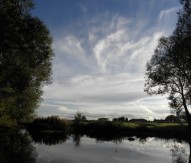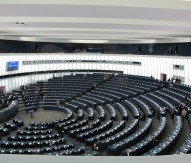
The research agenda
As the EU’s united investment scheme for research and innovation, Horizon 2020 has been heralded as a break from the past compared to previous framework programmes. With a significant emphasis on simplification, faster time to grant and addressing the major challenges facing European society, the European Commission has allocated nearly €80bn of funding to the R&I framework programme as it seeks to attract research proposals from across the university, research and business sectors. By realising its objectives, Horizon 2020 aims to encourage economic growth, job creation and bring more innovative and scientific breakthroughs to market.

Robert-Jan Smits © European Union, 2015
One of the areas where the R&I framework programme seeks to bring particular benefits is helping to address the challenges facing Europe’s environment. This year’s Green Week 2015 in Brussels at the beginning of June, focused on Nature and biodiversity, and discussed how ‘protecting Nature and maintaining Europe’s competitiveness must go hand in hand’ as such ‘policies can play a key role in creating jobs and stimulating investment’.
Green agenda
During this year’s event, Robert-Jan Smits, director general of DG Research and Innovation in the European Commission, took part in the session ‘Nature protects’, which discussed examples of how Nature-based solutions can ‘effectively mitigate the impacts of natural hazards’, including climate change, and how natural infrastructure can have a ‘positive impact on local livelihoods and the environment’. In an exclusive interview with Portal, Smits began by outlining his enthusiasm for this major conference on European environmental policy.
“Green Week is a fantastic initiative, and it is very inspiring to see the number of enthusiastic people that were there, including the young people who have an enormous commitment to the green cause.
“During the ‘Nature protects’ workshop, we tried to remove the idea that the green agenda will be at the expense of job creation or competitiveness, which is not the case; the green agenda, economic growth, competitiveness and job creation can go hand in hand,” commented the director general.
“Recently, the Danish Environmental Protection Agency published a report which showed that over the last 15-20 years, EU legislation in the field of the environment has not only led to a better quality of life with lower air pollution,
but that there have been benefits for competitiveness and the creation of jobs. Nature-based solutions offer enormous potential for new jobs, for economic growth, for SMEs, and for all stakeholders to get together.”
Evaluation to resolution
Whereas EU policy has traditionally been concentrating on collecting data concerning the impact citizens and industry have on the environment, Smits observed that there had now been a step change that sees greater emphasis on developing solutions to help protect the environment.
“We have a long tradition in our environment programme focusing only on data collection, with hardly any priority on real remedies. We now have a big break with the past and are looking for concrete solutions, or are using data analysis to undertake problem-solving activities.
“Whilst we are continuing to collect data, because this remains essential, we are going to really invest in bringing solutions to the citizen. Consequently, Nature-based solutions is an area where we are going to devote significant financial resources in the years ahead under Horizon 2020, including the next calls and notably under the 2016-2017 Work Programme, because we really want to have demonstrations of Nature-based solutions.
“At the Green Week workshop, we focused very much on the issue of flooding. Each year we read about flooding in the UK, Italy, Hungary, etc., and how with Nature-based solutions we can find an approach to address this issue, for example through the creation of natural basins. But Nature-based solutions are also about the greening of cities and deserts, agriculture in the cities, and finding new ways to cool buildings through plants.
“Consequently, we really want to see and finance large scale demonstrators that show Nature-based solutions can work, and see groups of stakeholders and countries get together around such demonstrators, after which hopefully others will follow.”
Victims of success
Within the first six months of 2015, nearly 4,000 projects have received funding from the Commission under Horizon 2020. Over 45,000 research applications were received by the Commission between December 2013 and March 2015, including more than 17,000 during the first seven months, nine times the available funding.
Brussels has been pleased with the high participation rate, but figures also reveal a low success rate for applicants, averaging around 14% for Horizon 2020, compared to 19-22% for the Seventh Framework Programme. Smits said the situation was “the biggest problem” that he faces.
“We have put enormous attention on Horizon 2020 simplification by inserting a lot of measures to really make it much easier for applicants to have access to the programme. In addition, with our Participant Portal, we have a quicker time to grant and simpler application forms with everything now being electronic.
“Yet we are now becoming the victims of our success – we are flooded with proposals and up to now we have received around 50,000. The success rate in certain areas has now dropped to 12%, and that is extremely worrying. These results show that we have been successful with our simplification efforts, because the barriers to the programme have been reduced. It also indicates that we are getting it right with our challenge-based approach, as Horizon 2020 steps away from the thematic approach. The SME Instrument is also very popular, because we see that 20% of the applicants now are new commerce, mostly SMEs.
“So whilst we are successful on the one hand, we are facing a huge oversubscription on the other. This is not sustainable and the fear is that if the success rate is lower than 10%, researchers may be discouraged in making applications. The aim is therefore to increase success rates and consequently we are increasingly introducing a two-stage application procedure: the first stage asks for a proposal outline that is just a couple of pages long; this stage will have a low success rate. This is then followed by a second stage with a possible 30% success rate. This method is helping to manage the oversubscription problems.”
SMEs
One of the goals of Horizon 2020 is to encourage the greater involvement of businesses, and one of the techniques the Commission has introduced to realise this goal is the creation of the SME Instrument. Managed by the Executive Agency for Small and Medium-sized Enterprises, the near €3bn tool ‘helps high-potential SMEs to develop groundbreaking innovative ideas for products, services or processes that are ready to face global market competition’. Smits provided a further insight into the instrument’s success.
“There’s an increase in the participation, notably from SMEs, but also from industry, which can be explained through the SME Instrument. We are putting more emphasis on innovation, demonstrators, proof of concept, first-of-a-kind, pilot lines, and technology transfer and deployment. Because of this greater emphasis on innovation, we see that in the first calls of Horizon 2020, there is an increase in the number of industrial and SME participants.”
Break from the past
Horizon 2020 and its predecessors share the common themes of investing in ICT, nanotechnology, space research, as well as researcher training, and addressing major health, environment, energy and climate challenges. Portal asked the director general what makes this framework programme so much more significant to the future of Europe.
“Firstly, we are putting greater emphasis on the deployment of research results and getting these to market. We therefore have demonstrators and proof of concepts, as well as the InnovFin SME Guarantee Facility, which allows us to give grants through the European Investment Bank (EIB) and European Investment Fund to those projects that we feel are really close to the market. This is a big novelty compared to previous framework programmes as we put more emphasis on the deployment of research results than ever before.
“Second is the big emphasis on SMEs – 20% of the Horizon 2020 budget is going to be given to small and medium sized enterprises. This means many newcomers will become involved, which is healthy for the system.
“Third is the radical simplification. In my organisation, there is one person who is called ‘Mr Simplification’, and his job is purely to scout for critical comments on the web about our programme and then immediately take action to remedy them. For example, when UK participants complained that they had a problem with accounting in euros and had to transfer constantly between accounts in pounds and euros, we immediately addressed this issue.
“Finally, the challenge-driven approach is also a big novelty. Rather than being prescriptive, we are now identifying a societal problem, be it an ageing population, obesity, Ebola, vaccine development, and state this as the challenge, and allow the science community to develop the best solution. It’s a completely different way: less prescriptive and more open.”
EFSI
The deal between the Commission, the Council of the European Union and the European Parliament on the European Fund for Strategic Investments (EFSI) sees €2.2bn drawn from the budget of Horizon 2020 and invested into the new fund under the Investment Plan for Europe. One of the worries within the research community has been whether universities and research technology organisations will be able to take full advantage of the EFSI following the budget reallocation. Smits commented that the EFSI would offer “enormous potential for innovative projects”.
“If you look at the lists we have drawn up, there are thousands of projects which different EU member states have put forward. There are some very interesting innovation projects, including in the areas of ICT, Industry 4.0, the Internet of Things and energy systems, etc. We now need to make sure that the innovators in Europe are aware of the EFSI and that the fund is not just available for major infrastructure projects, but also for innovative projects; the EIB is playing its role in assessing and evaluating each project,” commented Smits.
Risk sharing
The Commission has already worked very closely with the EIB in supporting investment in research and development projects through the Risk-Sharing Finance Facility (RSFF). The instrument saw the EU institution and the EU bank collaborate financially to ‘improve access to … debt finance for participants of European R&D projects’.
“The RSFF loans supported very high risk research and innovation projects which led to competence in the field of investing in R&I in the EIB,” Smits explained. “Over the last six years, we have been awarded €12bn in loans to innovative projects. Thanks to the RSFF the bank now has great skill in innovation, allowing it to assess projects and undertake due diligence, since, for example, investing in the Paris Metro is very different to investing in the next-generation biorefinery, Industry 4.0 project, or next-generation manufacturing.
“The due diligence competency of the EIB has been developed, and the bank is able to effectively assess innovation projects. We now need to make sure that we bring forward good projects which then can benefit from the EFSI.”
Introduced under Horizon 2020, and replacing the RSFF, is InnovFin, a joint initiative between the EIB Group and the Commission as part of Horizon 2020. According to the EIB, the instrument “consists of a series of integrated and complementary financing tools and advisory services offered by the EIB Group, covering the entire value chain of research and innovation in order to support investments from the smallest to the largest enterprise”. By 2020, it is anticipated that InnovFin will make available over €24bn of debt and equity financing to innovative companies, thus supporting €48bn of investment in R&I.
Next steps
The Commission is currently finalising the next work programmes under Horizon 2020, covering the years of 2016-2017, with a budget of €10bn during 2016 alone, an 11.6% increase on 2015. Portal asked Smits what developments scientists and researchers could expect to see in the next two years.
“The 2016-2017 work programmes will support more than ever the political agenda of President Jean-Claude Juncker, be it on the Energy Union, Smart Cities, the Circular economy or the Digital Single Market.”
Brussels has made major advances in funding research and innovation with the creation of Horizon 2020. The success of the programme is underlined by the significant interest from the research community and the number of funding applications submitted. Coupled with a challenge-based approach, simplification and new tools to encourage the involvement of industry, the latest R&I framework appears to satisfy many of the demands of scientists and researchers.
The EU institution has now also attempted to allay fears that a cut in the budget of Horizon 2020 following the creation of the EFSI would damage opportunities presented in the framework programme. As the new fund begins its work this summer, along with the final adjustments to the new work programmes and an ever-increasing number of applicants to Horizon 2020, it will again be up to the research community to witness themselves that this R&I programme is truly a successful break from the past.
Robert-Jan Smits
This article is also published in the seventh edition of Portal, which is now available to read online.




